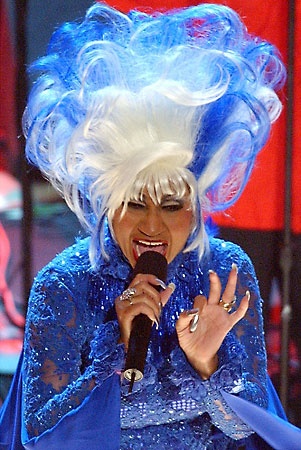Cruz, Celia
Cuban singer
born October 21, 1929?, Havana, Cuba
died July 16, 2003, Fort Lee, New Jersey, U.S.
 Cuban singer who reigned for decades as the “Queen of Salsa Music,” electrifying audiences with her wide-ranging, soulful voice and rhythmically compelling style.
Cuban singer who reigned for decades as the “Queen of Salsa Music,” electrifying audiences with her wide-ranging, soulful voice and rhythmically compelling style.Cruz never divulged the exact year of her birth. She grew up in Santos Suárez, a district of Havana, in an extended family of 14. After high school she attended the Normal School for Teachers in Havana, intending to become a literature teacher. After winning a talent show, however, in which she interpreted the tango piece "Nostalgia" in a bolero tempo, Cruz interrupted her studies to pursue a singing career. Her musical breakthrough came in 1950 when she replaced lead singer Myrta Silva of the popular orchestra La Sonora Matancera. Cruz sang regularly with the ensemble on radio and television, toured extensively, and appeared with it in five films produced in Mexico. She also headlined Havana's Tropicana nightclub in the 1950s.
After the Cuban revolution of 1959, Havana's nightlife all but disappeared. La Sonora Matancera left Cuba for Mexico and then the United States. In 1962 Cruz married the orchestra's first trumpet player, Pedro Knight, who became her musical director and manager after she became a solo artist. Despite recording 20 albums for Seeco Records and several for Tico Records (including 7 with bandleader Tito Puente (Puente, Tito)), Cruz was slow to find a wide audience in the United States during the 1960s. Success came after she became identified with salsa, a Hispanic dance music that evolved from musical experimentation with Caribbean sounds. Cruz re-created herself for a younger generation of Hispanics by singing in the Latin opera Hommy (1973; a version of the rock opera Tommy) in New York's Carnegie Hall and by recording updated Latin classics for Johnny Pacheco's Vaya record label (Celia & Johnny, 1974). With a voice described as operatic, she moved through high and low pitches with an ease that belied her age, and her style of improvising rhymed lyrics added a distinctive flavour to salsa. Her flamboyant costumes, which included varicoloured wigs, tight sequined dresses, and outlandishly high heels, became so famous that one of them was acquired by the Smithsonian Institution.
In her later years Cruz earned renown in a wider circle. She was the subject of a BBC documentary, My Name Is Celia Cruz (1988), and appeared in the films The Mambo Kings (1992) and The Perez Family (1995). Her autobiography, Celia: My Life (2004; originally published in Spanish), was written with Ana Cristina Reymundo. Her many honours included three Grammy Awards and three Latin Grammys for recordings such as Ritmo en el Corazón (1988) and Siempre Viviré (2000).
Additional Reading
Eduardo Marceles, Azúcar!: The Biography of Celia Cruz (2004), is a translation based on a revision of the original Spanish edition.
- Valley of Ten Thousand Smokes
- Valley of the Kings
- Valley of the Queens
- Valli, Romolo
- Val Logsdon Fitch
- Vallombrosa
- Vallès, Jules
- Val McCalla
- Valois
- Valois Dynasty
- Valparaiso
- Valparaiso University
- Valparaíso
- Valsad
- Valtellina
- value-added tax
- Values for the maximum permissible concentration (MPC) of certain radionuclides
- Values of the constant of gravitation
- valve
- Valéria Dienes
- Valéry Giscard d'Estaing
- Valéry, Paul
- vampire
- vampire bat
- Van